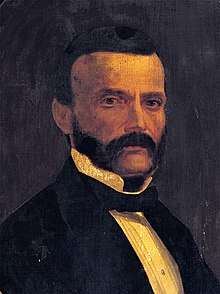Lerdo law
The Lerdo Law , or Ley Lerdo in Spanish, is the common name for the Reform law formally known as the Confiscation of Law and Urban Ruins of the Civil and Religious Corporations of Mexico. It was drafted by Miguel Lerdo de Tejada and issued on 25 June 1856 by Vice-President Ignacio Comonfort.[1]
Its objectives were to create a rural middle class, promote development, improve public finances of the state, and revive the economy by eliminating restrictions on freedom of movement. The latter was considered by Ignacio Compnfort as one of the biggest obstacles to prosperity.

The Lerdo Law provided for the confiscation of the lands held by the Catholic Church and civil corporations and their sale to private individuals. It was expected to stimulate the market and generate government revenue through sales tax. However, the lack of capital among the lower classes meant that the main purchasers were large landowners or foreign investors, further concentrating land ownership. Religious groups and their civil corporations were prohibited from purchasing land sold under the Lerdo Law unless it was necessary for strictly-religious purposes.
The law was part of the multiple Reform Laws that sought to establish the separation of church and state, the abolition of ecclesiastical privileges (fueros), and the secularization of registration of births, deaths and marriages (giving rise to the Civil Registry).
Excluded properties
As stipulated in Article 8 of the Lerdo law, they were exempt from the alienation buildings used immediately and directly to the service or object institute corporations, even if somewhere is leased not separate from them, such as convents, Episcopal palaces and municipal schools, hospitals, hospices, markets, houses of correction Charities. Properties belonging to municipalities, also excepted buildings, open lands and land used exclusively for the public service of the populations they belonged.
Fiscal consolidation
All translations domain of rural and urban properties to be executed under the law, cause the sales tax of five percent, which was to be paid in the corresponding general government offices. Such tax contribution would be in cash and debt bonds, depending on the time it had taken in verified awards. With these policies, the Mexican government intended to increase the low level of tax revenue to which it faced and improve public finances.
Impact on Indian communities
The Lerdo law by requiring that civil corporations stripped of its real estate, seriously damaged the foundation of the economy of indigenous communities, which owned all the land within its boundaries. These territories represent a significant income for communities, as they generally were leased to third parties to raise funds, so that their loss further worsened the situation of many indigenous people already living in poverty.
The Indians demanded the then Finance Minister Miguel Lerdo de Tejada that their property rights be respected. However, according to the Lerdo law, those rights were respected to protect the rights of tenants to buy their own land before offering them to foreign buyers.
To prevent their lands were acquired by others, sometimes the Indians went before a judge to acquire as an individual; however, these officials used to charge very high wages and high taxes of sale, so that the recovery process was complicated land. In other cases, judges were fraudulent dealings with people interested in the territories in order to acquire land even before the natives learn of the existence of the Lerdo law, making it virtually impossible for communities retain their territories.
References
- ↑ D.F. Stevens, "Ley Lerdo" in Encyclopedia of Latin American History and Culture, vol. 3, p. 409. New York: Charles Scribner's Sons 1996.
Further reading
- Bazant, Jan. Alienation of Church Wealth in Mexico: Social and Economic Aspects of the Liberal Revolution, 1856-1875. Trans. by Michael Costeloe. Cambridge: Cambridge University Press 1971.
- Berry, Charles R. The Reform in Oaxaca, 1856-76: A Microhistory of the Liberal Revolution. 1981.
- Callcott, Wilfred H. Liberalism in Mexico, 1857-1929. Stanford: Stanford University Press 1931.
- Knowlton, Thomas J. Church Property and the Mexican Reform, 1856-1910. Dekalb: Northern Illinois University Press 1976.
- Powell, Thomas Gene, El liberalismo y el campesinado en el centro de México, 1850-1877. 1974.
- Powell, Thomas Gene, "Priests and Peasants in central Mexico: Social Conflict during La Reforma," Hispanic American Historical Review, vol 57, no. 2. 1977: 296-313.
- Scholes, Walter V. Mexican Politics During the Juárez Regime, 1855-1872. Columbia: University of Missouri Press 1957.
- Sinkin, Richard N. The Mexican Reform, 1855-1876: A Study in Liberal Nation-Building. Austin: University of Texas Press 1979.
- Stevens, D.F. "Ley Lerdo" in Encyclopedia of Latin American History and Culture, vol. 3, p. 409. New York: Charles Scribner's Sons 1996.
External links
- http://www.biblioteca.tv/artman2/publish/1856_149/Ley_Lerdo_Ley_de_desamortizaci_n_de_bienes_de_la_i_247.shtml. Missing or empty
|title=(help) La referencia utiliza parámetros obsoletos (ayuda) Categoría:Wikipedia:Páginas con referencias con parámetros obsoletos - Ley de desamortización de bienes de la Iglesia y de corporaciones [ ]